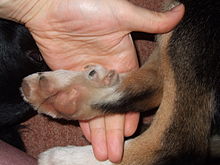- Dewclaw
-
For the web-comic characters of the same last name, see Kevin and Kell.
A dewclaw (commonly referred to as a Dog's thumb) is a vestigial digit on the foot of many mammals, birds, and reptiles (including some extinct orders, like certain theropods). It commonly grows high on the leg so that in digitigrade species, when the animal is standing, it does not make contact with the ground. Dewclaws are perhaps best known in dogs, and they are often removed in young puppies, though there is debate on whether this is necessary.
Contents
Dogs
Dogs almost always have dewclaws on the inside of the front legs and occasionally also on the hind legs.[1] Unlike front dewclaws, rear dewclaws tend to have little bone or muscle structure in most breeds. Sometimes some dogs will even have more than one dewclaw on the same foot; often at least one of these dewclaws will be poorly connected to the leg and in this case it is often surgically removed. When a dog has extra dewclaws in addition to the usual one on each front leg, the dog is said to be double dewclawed. There is some debate about whether a dewclaw helps dogs to gain traction when they run because in some dogs, the dewclaw makes contact when they are running and the nail on the dewclaw often wears down in the same way that the nails on their other toes do, from contact with the ground. However, in many dogs the dewclaws never make contact with the ground; in this case, the dewclaw's nail never wears away, and it is then often trimmed to keep it to a safe length.
The dewclaws are not dead appendages. They can be used to lightly grip bones and other items that dogs hold with the paws. However, in some dogs these claws may not appear to be connected to the leg at all except by a flap of skin; in such dogs the claws do not have a use for gripping as the claw can easily fold or turn. [2]
There is also some debate as to whether dewclaws should be surgically removed.[citation needed] The argument for removal states that dewclaws are a weak digit, barely attached to the leg, so that they can rip partway off or easily catch on something and break, which can be extremely painful and prone to infection. Others say the pain of removing a dewclaw is far greater than any other risk. For this reason, removal of dewclaws is illegal in many countries[citation needed]. There is, perhaps, an exception for hunting dogs, who can sometimes tear the dewclaw while running in overgrown vegetation. [3] If a dewclaw is to be removed, this should be done when the dog is a puppy, sometimes as young as 3 days old, though it can also be performed on older dogs if necessary (though the surgery may be more difficult then). The surgery is fairly straight-forward and may even be done with only local anesthetics if the digit is not well connected to the leg. Unfortunately many dogs can't resist licking at their sore paws following the surgery, so owners need to remain vigilant.
In addition, for those dogs whose dewclaws make contact with the ground when they run, it is possible that removing them could be a disadvantage for a dog's speed in running and changing of direction, particularly in performance dog sports such as dog agility.
In America, some pups are commonly sold by breeders "dewclawed", that is with the dewclaws removed (as by a veterinarian) for perceived health and safety reasons. A few breed standards also call for it.
Rear dewclaws
Canids have four claws on the rear feet,[4] although some domestic dog breeds or individuals have an additional claw. A more technical term for this fifth claw on the rear legs is hind-limb-specific preaxial polydactyly.[5] Several genetic mechanisms can cause rear dewclaws; they involve the LMBR1 gene and related parts of the genome.[5] Rear dewclaws often have no phalanx bones and are attached by skin only.[6]
Hoofed animals
Hoofed animals walk on the tips of special toes, the hoofs. Cloven-hoofed animals walk on a central pair of hoofs, but many also have an outer pair of dewclaws on each foot. These are a little farther up the leg than the main hoofs, and similar in structure to them.[7] In some species (such as cattle) the dewclaws are much smaller than the hoofs and never touch the ground. In others (such as pigs and many deer), they are only a little smaller than the hoofs, and may reach the ground in soft conditions or when jumping. Some hoofed animals (such as giraffes and modern horses) have no dew claws.
References
- ^ Rice, Dan (2008). The Complete Book of Dog Breeding (2 ed.). Barron's Educational Series. p. 150. ISBN 978-0764138874.
- ^ Hoskins, Johnny D. (2001). Veterinary Pediatrics: Dogs and Cats from Birth to Six Months (3 ed.). Saunders. p. 251. ISBN 978-0721676654.
- ^ What To Do If Your Dog Tears A Dew Claw
- ^ Macdonald, D. (1984). The Encyclopedia of Mammals. New York: Facts on File. p. 56. ISBN 0-87196-871-1.
- ^ a b Park, K; Kang, J; Subedi, Kp; Ha, Jh; Park, C (Aug 2008). "Canine Polydactyl Mutations With Heterogeneous Origin in the Conserved Intronic Sequence of LMBR1" (Free full text). Genetics 179 (4): 2163–72. doi:10.1534/genetics.108.087114. ISSN 0016-6731. PMC 2516088. PMID 18689889. http://www.genetics.org/content/179/4/2163.long.
- ^ Hosgood, Giselle (1998). Small Animal Paediatric Medicine and Surgery. Butterworth-Heinemann. p. 236. ISBN 978-0750635998.
- ^ Perich, Shawn; Furman, Michael (2003). Whitetail Hunting: Top-notch Strategies for Hunting North America's Most Popular Big-Game Animal. Creative Publishing international. pp. 8, 9. ISBN 978-1589231290.
External links
Categories:- Vertebrate anatomy
- Dog anatomy
Wikimedia Foundation. 2010.




